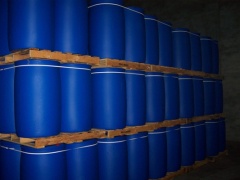Difference between revisions of "Detergents"
| (One intermediate revision by the same user not shown) | |||
| Line 7: | Line 7: | ||
| risk factors = See text | | risk factors = See text | ||
}} | }} | ||
| − | == | + | ==Description / Application== |
A detergent is a surfactant or a mixture of surfactants with "cleaning properties in dilute solutions. These substances are usually alkylbenzenesulfonates, a family of compounds that are similar to soap but are more soluble in hard water, because the polar sulfonate (of detergents) is less likely than the polar carboxyl (of soap) to bind to calcium and other ions found in hard water. In most household contexts, the term detergent by itself refers specifically to laundry detergent or dish detergent, as opposed to hand soap or other types of cleaning agents. Detergents are commonly available as powders or concentrated solutions. Detergents, like soaps, work because they are amphiphilic: partly hydrophilic (polar) and partly hydrophobic (non-polar). Their dual nature facilitates the mixture of hydrophobic compounds (like oil and grease) with water. Because air is not hydrophilic, detergents are also foaming agents to varying degrees.<br><br> | A detergent is a surfactant or a mixture of surfactants with "cleaning properties in dilute solutions. These substances are usually alkylbenzenesulfonates, a family of compounds that are similar to soap but are more soluble in hard water, because the polar sulfonate (of detergents) is less likely than the polar carboxyl (of soap) to bind to calcium and other ions found in hard water. In most household contexts, the term detergent by itself refers specifically to laundry detergent or dish detergent, as opposed to hand soap or other types of cleaning agents. Detergents are commonly available as powders or concentrated solutions. Detergents, like soaps, work because they are amphiphilic: partly hydrophilic (polar) and partly hydrophobic (non-polar). Their dual nature facilitates the mixture of hydrophobic compounds (like oil and grease) with water. Because air is not hydrophilic, detergents are also foaming agents to varying degrees.<br><br> | ||
==Shipment / Storage / Risk factors== | ==Shipment / Storage / Risk factors== | ||
| Line 13: | Line 13: | ||
If drums are damaged during transit the contents, through exposure and absorption of moisture from the atmosphere, may be contaminated, slightly discoloured, freely deliquescing and converted into a soft pasty mass, intermixed with small lumps. In such a state the detergent has little salvage value.<br><br> | If drums are damaged during transit the contents, through exposure and absorption of moisture from the atmosphere, may be contaminated, slightly discoloured, freely deliquescing and converted into a soft pasty mass, intermixed with small lumps. In such a state the detergent has little salvage value.<br><br> | ||
A variety of detergents are now being carried in bulk liquid form. Most of these are of a non hazardous nature, although many have an offensive odour. It is essential that tanks are thoroughly cleaned prior to loading and it is advisable to call survey of space before the cargo is accepted. | A variety of detergents are now being carried in bulk liquid form. Most of these are of a non hazardous nature, although many have an offensive odour. It is essential that tanks are thoroughly cleaned prior to loading and it is advisable to call survey of space before the cargo is accepted. | ||
| + | |||
| + | [[Category: Products]] | ||
| + | [[Category: Oil and chemicals]] | ||
Latest revision as of 14:10, 11 April 2013
| Infobox on Detergents | |
|---|---|
| Example of Detergents |  |
| Facts | |
| Origin | - |
| Stowage factor (in m3/t) | - |
| Humidity / moisture | 1,4 m3/t (bulk) |
| Ventilation | - |
| Risk factors | See text |
Detergents
Description / Application
A detergent is a surfactant or a mixture of surfactants with "cleaning properties in dilute solutions. These substances are usually alkylbenzenesulfonates, a family of compounds that are similar to soap but are more soluble in hard water, because the polar sulfonate (of detergents) is less likely than the polar carboxyl (of soap) to bind to calcium and other ions found in hard water. In most household contexts, the term detergent by itself refers specifically to laundry detergent or dish detergent, as opposed to hand soap or other types of cleaning agents. Detergents are commonly available as powders or concentrated solutions. Detergents, like soaps, work because they are amphiphilic: partly hydrophilic (polar) and partly hydrophobic (non-polar). Their dual nature facilitates the mixture of hydrophobic compounds (like oil and grease) with water. Because air is not hydrophilic, detergents are also foaming agents to varying degrees.
Shipment / Storage / Risk factors
In powder form, frequently shipped in metal drums.
If drums are damaged during transit the contents, through exposure and absorption of moisture from the atmosphere, may be contaminated, slightly discoloured, freely deliquescing and converted into a soft pasty mass, intermixed with small lumps. In such a state the detergent has little salvage value.
A variety of detergents are now being carried in bulk liquid form. Most of these are of a non hazardous nature, although many have an offensive odour. It is essential that tanks are thoroughly cleaned prior to loading and it is advisable to call survey of space before the cargo is accepted.











